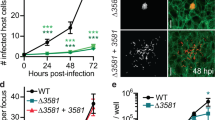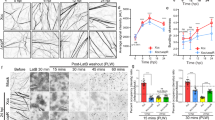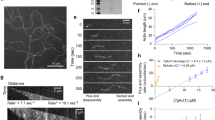Abstract
Enterohaemorrhagic Escherichia coli attaches to the intestine through actin pedestals that are formed when the bacterium injects its protein EspFU (also known as TccP) into host cells1. EspFU potently activates the host WASP (Wiskott–Aldrich syndrome protein) family of actin-nucleating factors, which are normally activated by the GTPase CDC42, among other signalling molecules. Apart from its amino-terminal type III secretion signal, EspFU consists of five-and-a-half 47-amino-acid repeats. Here we show that a 17-residue motif within this EspFU repeat is sufficient for interaction with N-WASP (also known as WASL). Unlike most pathogen proteins that interface with the cytoskeletal machinery, this motif does not mimic natural upstream activators: instead of mimicking an activated state of CDC42, EspFU mimics an autoinhibitory element found within N-WASP. Thus, EspFU activates N-WASP by competitively disrupting the autoinhibited state. By mimicking an internal regulatory element and not the natural activator, EspFU selectively activates only a precise subset of CDC42-activated processes. Although one repeat is able to stimulate actin polymerization, we show that multiple-repeat fragments have notably increased potency. The activities of these EspFU fragments correlate with their ability to coordinate activation of at least two N-WASP proteins. Thus, this pathogen has used a simple autoinhibitory fragment as a component to build a highly effective actin polymerization machine.
This is a preview of subscription content, access via your institution
Access options
Subscribe to this journal
Receive 51 print issues and online access
$199.00 per year
only $3.90 per issue
Buy this article
- Purchase on Springer Link
- Instant access to full article PDF
Prices may be subject to local taxes which are calculated during checkout



Similar content being viewed by others
References
Caron, E. et al. Subversion of actin dynamics by EPEC and EHEC. Curr. Opin. Microbiol. 9, 40–45 (2006)
Gruenheid, S. & Finlay, B. B. Microbial pathogenesis and cytoskeletal function. Nature 422, 775–781 (2003)
Rottner, K., Lommel, S., Wehland, J. & Stradal, T. E. Pathogen-induced actin filament rearrangement in infectious diseases. J. Pathol. 204, 396–406 (2004)
Campellone, K. G., Robbins, D. & Leong, J. M. EspFU is a translocated EHEC effector that interacts with Tir and N-WASP and promotes Nck-independent actin assembly. Dev. Cell 7, 217–228 (2004)
Garmendia, J. et al. TccP is an enterohaemorrhagic Escherichia coli O157:H7 type III effector protein that couples Tir to the actin-cytoskeleton. Cell. Microbiol. 6, 1167–1183 (2004)
Galan, J. E. & Wolf-Watz, H. Protein delivery into eukaryotic cells by type III secretion machines. Nature 444, 567–573 (2006)
Kim, A. S., Kakalis, L. T., Abdul-Manan, N., Liu, G. A. & Rosen, M. K. Autoinhibition and activation mechanisms of the Wiskott–Aldrich syndrome protein. Nature 404, 151–158 (2000)
Prehoda, K. E., Scott, J. A., Mullins, R. D. & Lim, W. A. Integration of multiple signals through cooperative regulation of the N-WASP–Arp2/3 complex. Science 290, 801–806 (2000)
Rohatgi, R., Nollau, P., Ho, H. Y., Kirschner, M. W. & Mayer, B. J. Nck and phosphatidylinositol 4,5-bisphosphate synergistically activate actin polymerization through the N-WASP–Arp2/3 pathway. J. Biol. Chem. 276, 26448–26452 (2001)
Mattoo, S., Lee, Y. M. & Dixon, J. E. Interactions of bacterial effector proteins with host proteins. Curr. Opin. Immunol. 19, 392–401 (2007)
Stebbins, C. E. Structural insights into bacterial modulation of the host cytoskeleton. Curr. Opin. Struct. Biol. 14, 731–740 (2004)
Mukherjee, S., Hao, Y. H. & Orth, K. A newly discovered post-translational modification — the acetylation of serine and threonine residues. Trends Biochem. Sci. 32, 210–216 (2007)
Aktories, K. & Barbieri, J. T. Bacterial cytotoxins: targeting eukaryotic switches. Nature Rev. Microbiol. 3, 397–410 (2005)
Zalevsky, J., Grigorova, I. & Mullins, R. D. Activation of the Arp2/3 complex by the Listeria acta protein. Acta binds two actin monomers and three subunits of the Arp2/3 complex. J. Biol. Chem. 276, 3468–3475 (2001)
Alto, N. M. et al. Identification of a bacterial type III effector family with G protein mimicry functions. Cell 124, 133–145 (2006)
Lommel, S., Benesch, S., Rohde, M., Wehland, J. & Rottner, K. Enterohaemorrhagic and enteropathogenic Escherichia coli use different mechanisms for actin pedestal formation that converge on N-WASP. Cell. Microbiol. 6, 243–254 (2004)
Garmendia, J., Carlier, M. F., Egile, C., Didry, D. & Frankel, G. Characterization of TccP-mediated N-WASP activation during enterohaemorrhagic Escherichia coli infection. Cell. Microbiol. 8, 1444–1455 (2006)
Alto, N. M. et al. The type III effector EspF coordinates membrane trafficking by the spatiotemporal activation of two eukaryotic signaling pathways. J. Cell Biol. 178, 1265–1278 (2007)
McNamara, B. P. et al. Translocated EspF protein from enteropathogenic Escherichia coli disrupts host intestinal barrier function. J. Clin. Invest. 107, 621–629 (2001)
Rost, B., Yachdav, G. & Liu, J. The PredictProtein server. Nucleic Acids Res. 32, W321–W326 (2004)
Panchal, S. C., Kaiser, D. A., Torres, E., Pollard, T. D. & Rosen, M. K. A conserved amphipathic helix in WASP/Scar proteins is essential for activation of Arp2/3 complex. Nature Struct. Biol. 10, 591–598 (2003)
Marchand, J. B., Kaiser, D. A., Pollard, T. D. & Higgs, H. N. Interaction of WASP/Scar proteins with actin and vertebrate Arp2/3 complex. Nature Cell Biol. 3, 76–82 (2001)
Lei, M. et al. Structure of PAK1 in an autoinhibited conformation reveals a multistage activation switch. Cell 102, 387–397 (2000)
Akin, O. & Mullins, R. D. Capping protein increases the rate of actin-based motility by promoting filament nucleation by the Arp2/3 complex. Cell 133, 841–851 (2008)
Castellano, F. et al. Inducible recruitment of Cdc42 or WASP to a cell-surface receptor triggers actin polymerization and filopodium formation. Curr. Biol. 9, 351–360 (1999)
Rivera, G. M., Briceno, C. A., Takeshima, F., Snapper, S. B. & Mayer, B. J. Inducible clustering of membrane-targeted SH3 domains of the adaptor protein Nck triggers localized actin polymerization. Curr. Biol. 14, 11–22 (2004)
Higgs, H. N. & Pollard, T. D. Activation by Cdc42 and PIP(2) of Wiskott–Aldrich syndrome protein (WASp) stimulates actin nucleation by Arp2/3 complex. J. Cell Biol. 150, 1311–1320 (2000)
Yarar, D., Waterman-Storer, C. M. & Schmid, S. L. SNX9 couples actin assembly to phosphoinositide signals and is required for membrane remodeling during endocytosis. Dev. Cell 13, 43–56 (2007)
Sallee, N. A., Yeh, B. J. & Lim, W. A. Engineering modular protein interaction switches by sequence overlap. J. Am. Chem. Soc. 129, 4606–4611 (2007)
Dayel, M. J., Holleran, E. A. & Mullins, R. D. Arp2/3 complex requires hydrolyzable ATP for nucleation of new actin filaments. Proc. Natl Acad. Sci. USA 98, 14871–14876 (2001)
Wang, W. & Malcolm, B. A. Two-stage PCR protocol allowing introduction of multiple mutations, deletions and insertions using QuikChange Site-Directed Mutagenesis. Biotechniques 26, 680–682 (1999)
Chong, C., Tan, L., Lim, L. & Manser, E. The mechanism of PAK activation. Autophosphorylation events in both regulatory and kinase domains control activity. J. Biol. Chem. 276, 17347–17353 (2001)
Machesky, L. M. et al. Scar, a WASp-related protein, activates nucleation of actin filaments by the Arp2/3 complex. Proc. Natl Acad. Sci. USA 96, 3739–3744 (1999)
Kaiser, D. A., Goldschmidt-Clermont, P. J., Levine, B. A. & Pollard, T. D. Characterization of renatured profilin purified by urea elution from poly-L-proline agarose columns. Cell Motil. Cytoskeleton 14, 251–262 (1989)
Palmgren, S., Ojala, P. J., Wear, M. A., Cooper, J. A. & Lappalainen, P. Interactions with PIP2, ADP-actin monomers, and capping protein regulate the activity and localization of yeast twinfilin. J. Cell Biol. 155, 251–260 (2001)
Acknowledgements
We thank O. Akin for reagents and assistance with the bead motility experiments; J. C. Anderson, A. Chau, R. Howard, M. Lohse, A. Remenyi and L. Weaver for assistance; and members of the Lim laboratory for discussion. This work was supported by grants from the NIH (NIGMS and Nanomedicine Development Centers, NIH Roadmap), the NSF and the Packard Foundation. G.M.R. was supported by the American Heart Association.
Author information
Authors and Affiliations
Corresponding author
Supplementary information
The file contains Supplementary Figures S1-S13 and Legends; Supplementary Methods and additional references.
The Supplementary Figures include: presentation of additional data from experiments shown in the main paper, circular dichroism, quantitative binding measurements, data for the synthetic linker construct, in vivo clustering experiment controls, analytical ultracentrifugation results and description of the Comet Detector algorithm. (PDF 5004 kb)
Rights and permissions
About this article
Cite this article
Sallee, N., Rivera, G., Dueber, J. et al. The pathogen protein EspFU hijacks actin polymerization using mimicry and multivalency. Nature 454, 1005–1008 (2008). https://doi.org/10.1038/nature07170
Received:
Accepted:
Published:
Issue Date:
DOI: https://doi.org/10.1038/nature07170
This article is cited by
-
A glycine-rich PE_PGRS protein governs mycobacterial actin-based motility
Nature Communications (2022)
-
1H, 13C, and 15N NMR chemical shift assignment of the complex formed by the first EPEC EspF repeat and N-WASP GTPase binding domain
Biomolecular NMR Assignments (2021)
-
Mechanism of actin filament nucleation by the bacterial effector VopL
Nature Structural & Molecular Biology (2011)
-
A new twist in actin filament nucleation
Nature Structural & Molecular Biology (2011)
-
A nucleator arms race: cellular control of actin assembly
Nature Reviews Molecular Cell Biology (2010)
Comments
By submitting a comment you agree to abide by our Terms and Community Guidelines. If you find something abusive or that does not comply with our terms or guidelines please flag it as inappropriate.



